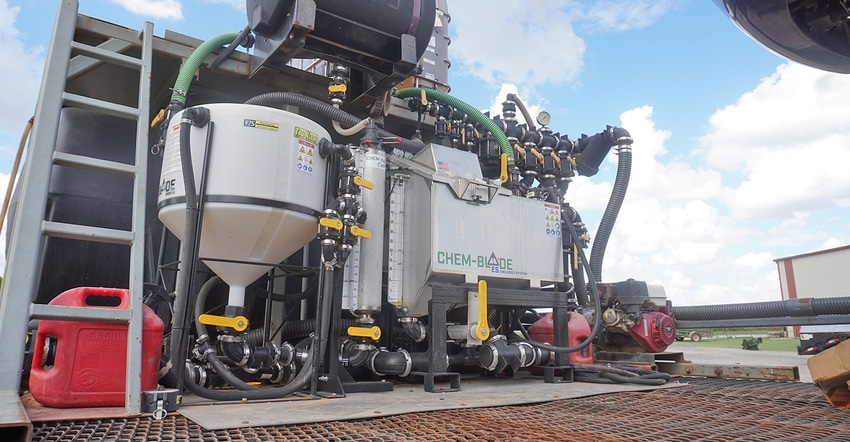November 5, 2018

Farm-focused inventions come from a lot of different ideas. For Kansas inventor Ethan Eck, the idea for a new product happened when he returned to the farm several years ago. Trained to work in the automotive and motor sport chassis business, his new chores were in a different part of the business, which ended up creating a new opportunity.
“My brother got into custom spraying earlier than others, and to support our first sprayers, let’s just say I was at the bottom rung on the farm,” Eck says. “That meant I had to pour the jug into the eductor and fill the sprayer to keep it going. Then, I would have even more fun on another day, when I would line up all the empty jugs in the shop to rinse them out into a 100-gallon tote — filling it with a range of chemicals. I did not like that.”
With necessity driving him, Eck figured he could cut the crop protection jug to get the material, but what else could he do? That’s when the first Chem-Blade was developed.
This was a small unit with a triangular blade that would immediately open the jug and dump the contents to be pulled into the sprayer. The unit would also spray-rinse the jug. In essence, all the chemical in the jug went into the sprayer and onto the field, not into one of those catchall totes later.
Several iterations of system
That was several years ago — and a few iterations of the system, too. Today, Chem-Blade is a Kansas manufacturer that makes and distributes its systems to dealers throughout North America. And for the 2019 season, the company has launched the Chem-Blade ES, for “enclosed system.”
“The ES is the culmination of a lot of work and has years of tech in it,” Eck explains. “This is a closed system that moves product into the sprayer as fast as possible.”
Eck knows that farmers are dealing with cost pressures and need to keep equipment working in the field as much as possible. “Farmers need to maximize their bottom line, and if they’re loading a big sprayer faster and getting back in the field, that’s improving productivity,” he says. “We can gain them an hour of spraying a day. How many extra acres could you spray in that hour before the storm hits?”
On top of that, he adds, there’s a safety factor, too; with the enclosed system isolating the operator from the pesticides. The unit can handle up to 2.5-gallon jugs, or dry material in bags as big as 50 pounds.
Water for the system comes from before a venturi manifold. This means no extra rinse water source is required; all chemical and rinsate water goes straight into the sprayer, where it can do the most work.
Deploying the system
Eck explains that the Chem-Blade ES can be mounted on a semitrailer to be part of a tending system. And he sees that as a common use for the product. In addition, the unit can be ground-based for use in a tending shed — or at an airport, to help tend an aerial application system.
Price for the machine ranges from $16,500 to $24,000, depending on the options, plumbing and other features. The company also offers the Chem-Blade Caddy as an add-on option that can be used with partial containers, measuring to the exact ounce in a closed system, which offers added flexibility.
“We tried to limit the number of models, but with tiny changes or options for plumbing, the number climbs,” Eck explains. “We have 30 models of the ES now, and most of that is just changing plumbing fittings to fit different spraying setups. We have designed the ES to fit most any semitruck-trailer scenario, and the farmer can readily gain that extra time spraying.”
As for that extra hour? Eck notes that with a 120-foot boom, a sprayer is worth about $20 per minute operating, so that extra hour per day has an easy-to-calculate value of $1,200 per hour. “It’s relatively easy to calculate a return on investment to the machine; it’s harder to calculate a return on investment for the added safety of the closed system that protects the operator.”
If you’re interested in the new system, visit chem-blade.com for more information.
About the Author(s)
You May Also Like






